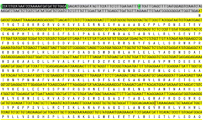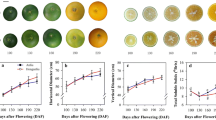Abstract
The cucumber (Cucumis sativus L.) gene Cucumis sativus Somatic Embryogenesis Zinc Finger 1 (CsSEF1) was suggested to be a good marker gene for sugar starvation in fruit. The expression of this gene in fruits is dramatically upregulated in plants that have suffered either complete defoliation or prolonged darkness. CsSEF1 was initially discovered as a gene that was upregulated during somatic embryogenesis. We examined the difference in fruit parts and the effect of pollination on the upregulation of CsSEF1 induced by defoliation treatment. The results indicated that the upregulation of CsSEF1 in fruit by defoliation is not dependent on the presence of developing embryos. The expression of CsSEF1 was upregulated in malformed fruit induced by salinity in which the development of placenta was arrested. Partial cutting of the distal part of the fruit showed that if placenta tissue remained there was no upregulation of CsSEF1, whereas when placenta tissue did not remain there was a marked upregulation of CsSEF1. These results could be consistently interpreted as showing that placenta tissue induced the transport of photoassimilates to the fruit and that without developing placenta tissue, pericarp tissue suffers from severe sugar starvation. This interpretation, in turn, enforces the view that CsSEF1 is a good marker gene of fruit sugar starvation.




Similar content being viewed by others
References
Badgery-Parker J, James L, Javis J, Parke S (2010) Commercial greenhouse cucumber production. Industry and Investment NSW, State of New South Wales
Blasing OE, Gibon Y, Grunther M, Hohne M, Morcuende R, Osuna D, Thimm O, Usadel B, Scheibe W-R, Stitt M (2005) Sugars and circadian regulation make major contributions to global regulation of diurnal gene expression in Arabidopsis. Plant Cell 17:3257–3281
Bogamuwa S, Jang J-C (2013) The Arabidopsis tandem CCCH zinc finger proteins AtTAF4, 5 and 6 are involved in light-, abscisic acid- and gibberellic acid-mediated regulation of seed germination. Plant Cell Environ 36:1507–1519
Contento AL, Kim SJ, Bassham DC (2004) Transcriptome profiling of the response of Arabidopsis suspension culture cells to Suc starvation. Plant Physiol 135:2330–2347
D’Orso F, De Leonardis AM, Salvi S, Gadaleta A, Rubert I, Cattivelli L, Giorgio M, Mastrangelo AM (2016) Conservation of AtTZF1, AtTZF2, and AtTZF3 homolog gene regulation by salt stress in evolutionarily distant plant species. Front Plant Sci 7:254
Grabowska A, Winsniewska A, Tagashira N, Malepszy S, Filipecki M (2009) Characterization of CsSEF1 gene encoding putative CCCH-type zinc finger protein expressed during cucumber somatic embryogenesis. J Plant Physiol 166:310–323
Guo YH, Yu YP, Wang D, Wu CA, Yang GD, Huang JG, Zheng CC (2009) GhZFP1, a novel CCCH-type zinc finger protein from cotton, enhances salt stress tolerance and fungal disease resistance in transgenic tobacco by interacting with GZIRD21A and GZIPR5. New Phytol 183:62–75
Han G, Wang M, Yuan F, Sui N, Song J, Wang B (2014) The CCCH zinc finger protein gene AtZFP1 improves salt resistance in Arabidopsis thaliana. Plant Mol Biol 86:237–257
Huang P, Chung M-S, Ju H-W, Na H-S, Lee DJ, Cheong H-S, Kim CS (2011) Physiological characterization of the Arabidopsis thaliana oxygen-related zinc finger 1, a plasma membrane protein involved in oxidative stress. J Plant Res 124:699–705
Jan A, Maruyama K, Todaka D, Kidokoro S, Abo M, Yoshimura E, Shinozaki K, Nakashima K, Yamaguchi-Shinozaki K (2013) OsTZF1, a CCCH-tandem zinc finger protein, confers delayed senescence and stress tolerance in rice by regulating stress-related genes. Plant Physiol 161:1202–1216
Kato R, Oda H (1977) Studies on the physiological disorders in fruit vegetable crops under plastic films. VIII. On the occurrence of abnormal fruits in cucumber plants. (II) On the development of carrot type and bottle gourd type fruits, so-called sakibosori and shiributo fruits in Japan. (Japanese text with English abstract). Res Rep Kouchi Univ (Agr Sci) 26:175–182
Kim DH, Yamaguchi S, Lim S, Oh E, Park J, Hanada A, Kamiya Y, Choi G (2008) SOMNUS, a CCCH-type zinc finger protein in Arabidopsis, negatively regulates light-dependent seed germination downstream of PIL5. Plant Cell 20:1260–1277
Kong Z, Li M, Yang W, Xu W, Xue Y (2006) A novel nuclear-localized CCCH-type zinc finger protein, OsDOS, is involved in delaying leaf senescence in rice. Plant Physiol 141:1376–1388
Lam HM, Hsieh MH, Coruzzi G (1998) Reciprocal regulation of distinct asparagine synthetase genes by light and metabolites in Arabidopsis thaliana. Plant J 16:345–353
Lee SJ, Jung HJ, Kang H, Kim SY (2012) Arabidopsis zinc finger proteins AtC3H49/AtTZF3 and AtC3H20/AtTZF2 are involved in ABA and JA responses. Plant Cell Physiol 53:673–686
Li Z, Thomas TL (1998) PEI1, an embryo-specific zinc finger protein gene required for heart-stage embryo formation in Arabidopsis. Plant Cell 10:383–398
Lin P-C, Pomeranz MC, Jikumaru Y, Kang SG, Hah C, Fujioka S, Kamiya Y, Jang J-C (2011) The Arabidopsis tandem zinc finger protein AtTZ1 affects ABA- and GA-mediated growth, stress and gene expression responses. Plant J 65:253–268
Pomeranz M, Finer J, Jang J-C (2011) Putative molecular mechanism underlying tandem CCCH zinc finger protein mediated plant growth, stress and gene expression responses. Plant Signal Behav 6:647–651
Price J, Laxmi A, St Martin SK, Jang JC (2004) Global transcription profiling reveals multiple sugar signal transduction mechanisms in Arabidopsis. Plant Cell 16:2128–2150
R Development Core Team (2015) R: a language and environment for statistical computing. R Foundation for Statistical Computing. Vienna, Austria. http://www.R-project.org
Sun J, Jiang H, Xu Y, Li H, Wu X, Xie Q, Li C (2007) The CCCH-type zinc finger proteins AtSZF1 and AtSZF2 regulate salt stress responses in Arabidopsis. Plant Cell Physiol 48:1148–1158
Tazuke A (1997) Effects of adding NaCl and reducing aeration to nutrient culture solution on the growth of cucumber fruit. J Jpn Soc Hort Sci 66:563–568
Tazuke A (2001) Sugar concentration of cucumber fruits as affected by NaCl addition to nutrient solution. (Japanese text with English abstract). Environ Control Biol 39:281–288
Tazuke A, Asayama M (2013) Expression of CsSEF1 gene encoding putative CCCH zinc finger protein is induced by defoliation and prolonged darkness in cucumber fruit. Planta 237:681–691
Tazuke A, Kinoshita T, Asayama M (2015) Expression of the BTB/POZ domain-containing protein Atg63850-like gene CsFDI1 is enhanced by sugar starvation in cucumber fruit. Acta Physiol Plant 37:15
Thum KE, Shin MJ, Palenchar PM, Kouranov A, Corzzi GM (2004) Genome-wide investigation of light and carbon signaling in Arabidopsis. Genome Biol 5:R10
Varga A, Bruinsma J (1990) Dependence of ovary growth on ovule development in Cucumis sativus. Physiol Plant 80:43–50
Zhou T, Yang X, Wang L, Xu J, Zhang X (2014) GhTZF1 regulates drought stress responses and delays leaf senescence by inhibiting reactive oxygen species accumulation in transgenic Arabidopsis. Plant Mol Biol 85:163–177
Acknowledgements
This work was supported by JSPS KAKENHI (Grant No: 22580285).
Author information
Authors and Affiliations
Corresponding author
Rights and permissions
About this article
Cite this article
Tazuke, A., Kinoshita, T. & Asayama, M. The expression of a candidate cucumber fruit sugar starvation marker gene CsSEF1 is enhanced in malformed fruit induced by salinity. Physiol Mol Biol Plants 23, 565–570 (2017). https://doi.org/10.1007/s12298-017-0452-9
Received:
Revised:
Accepted:
Published:
Issue Date:
DOI: https://doi.org/10.1007/s12298-017-0452-9




